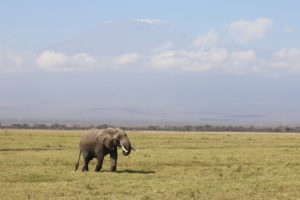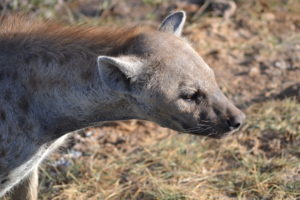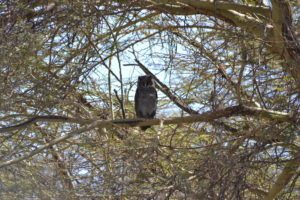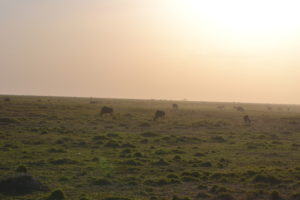The next stage of our journey was to take us to Amboseli National Park in Southern Kenya. The park and its surrounding area is famous for its elephants, with much of the key work on elephant behaviour developed through study of the Amboseli families. With such a huge elephant population the area is a flashpoint of human-wildlife conflict concerning elephants raiding crops and attacking people. It was this conflict that we were interested in, as a very different problem to that of predator-human conflict that our project in Nairobi is dealing with. In the Amboseli region we were to visit the national park to gain a perspective of the density of the elephant population as well as key local organisations that are attempting to manage the various conservation issues that concern such a population.
Before undertaking our investigation of the Amboseli region we first has to leave Niavasha. This was easier said than done. We were to say goodbye to our driver Isaac and his irrepressible van (“the van that can”), replacing each with a new driver and car to continue our journey to Amboseli. Having waived Isaac and his van goodbye we were to wait at the camp for the new vehicle… and wait we did. The day was to be spent sitting outside our huts in the sun with regular calls to the driver trying to establish where on earth he had got to. If Isaac’s van had been the van that can, this car was certainly the land rover that couldn’t. Shortly after sunset a very ill sounding land rover was to roll into camp before grinding to a choking halt, leaking axle fluid, lacking seat belts and requiring us to learn how to hot wire a car to get the engine started. After some mildly electrocuted fingers we managed to restart the car to allow us to reach our dinning destination. Over dinner that evening we decided that the land rover would not be up to the greater than six hour drive to Amboseli. Enoch, pragmatic as ever, was able to organise his car to be driven up to Niavasha from Nairobi for our use the next morning in the drive down to Amboseli.
Setting out the next morning we were in for six hours of overtaking huge caravans of dangerously overloaded HGVs and choking through the smog they belched from their exhausts. Bruised and dust stained we arrived at our campsite and collapse into sleep plagued by strange anti-malarial induced dreams.

Waking before dawn we were met with the sight of Mt Kilimanjaro set ablaze by the rising sun. In the shadow of the world’s tallest free standing mountain we took a quick breakfast before jumping into our car to see Amboseli National Park. Like the Maasai Mara, Amboseli is an unfenced park located within an area of largely open, Maasai owned community land, part of a larger ecosystem spanning across the Tanzanian boarder. Unlike the Maasai Mara, but like Nairobi National Park, Amboseli is central government run, potentially leading to an increase in conflict with local people as locals receive minimal benefits from the park entry fees whist shouldering the burden of living alongside the high wildlife densities the park produces. The park itself was stunning, the morning sun lighting up the wetlands that make up the core of the park, the water shining gold around the legs of the wading elephants that dotted the open plain as far as the eye could see. As the day wore on and the temperature rocketed the glow of the sunrise was to be replaced by a heavy heat haze, driving all the animals of the park to take refuge in the wetlands. This was to our advantage facilitating stunning views of spotted hyena (Crocuta crocuta), African buffalo (Syncerus caffer), zebra (Equus burchelli), and elephants (Loxodonta africanus) all lounging within a few meters of one another. Amboseli also provided a stunning exhibition of some of East Africa’s most impressive bird life including the endangered lappet-faced vulture (Trogos tracheliotus) and one of the world’s largest owl species, Verreaux’s eagle-owl (Bubo lacteaus). Views of such a biodiverse and lush park were in stark contrast to the dry and dusty surrounding community land. This contrast provided the context for the resentment felt by local pastoralists who compete with wildlife for access limited pasture.




With the context provided by the park we were to investigate the conservation and human-wildlife conflict issues faced in the area, alongside potential solutions, by a visit to the headquarters of the conservation organisation Big Life. At Big Life HQ we met with the organisations programs manager Samar Ntalamia with whom we discussed the organisations major programs: The employment of a squad of over 250 anti-poaching rangers from the local community; the provisioning of communities with tangible benefits from wildlife conservation through sponsoring the education of bright children and employment of more teachers in local schools; The establishment a compensation program for local farmers who lose livestock to wildlife; the Moran education program, initiating culture change among young Maasia to halt ceremonial killing of lions, providing alternative outlets for shows of strength and skill through the Maasai Olympics. To demonstrate the success of Big Life’s programs Samar gave us access to the elephant poaching data collected by Big Life, a detailed database of all the elephant poaching events in the ecosystem since Big Life’s initiation. Though the accounts are a harrowing read, it is heartening to see how the situation has improved as Big Life have developed their programs in the area.
Impressed by what we had heard of Big Life’s programs so far we were to be taken to see some of their work on the ground. With Big Life’s conservation education officer we made our way to a local school which was support by Big Life through the employment of teachers and the running of conservation education classes. At the school we met with staff to discuss the challenges education faced in the area and the interplay between education and wildlife conservation. A dramatically different picture of school life was painted to that which most of us had grown up with. Here education issues are rather different from those faced by UK primary schools, no mention of SATs of teacher’s pay, rather problems with children needing to leave school early to avoid elephants and lions on the way home.
Returning to Big Life HQ we were to meet with the organisation’s Director of Operations Richard Bonham before taking our leave. With Richard we discussed the wider issues of human-wildlife conflict in the region and the potential future of funding and governance for conservation work in East Africa. Having felt thoroughly impressed and welcomed by Big Life we retired once again to our camp.
The following day we were to return to Nairobi for the final stage our expedition to assess how the camera traps had fared following long term deployment, before a final briefing with the local community to set the project off on its next stage. With one final look at the dizzying peak of Mt Kilimanjaro we alighted from camp for our final bone-rattling, dust covered cross country journey through Kenya.
Poorly organised pictures and prose courtesy of Tom Jameson.
